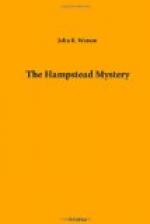No light was thrown on the cause of the murdered man’s sudden return from grouse-shooting in Scotland. The newspaper accounts, though they differed greatly in their statements, surmises, and suggestions concerning the tragedy, agreed on the point that Sir Horace had been a keen sportsman and was a very fine shot. In years past he had made a practice of spending the early part of the long vacation in Scotland, going there for the opening of the grouse season on the 12th of August. This year he had been one of a party of five who had rented Craigleith Hall in the Western Highlands, and after five days’ shooting he had announced that he had to go to London on urgent business, but would return in the course of a week or less. It was suggested in some of the newspaper accounts that an explanation of the cause of his return might throw some light on the murder. Inquiries were being made at Craigleith Hall to ascertain the reason for his journey to London, or whether any telegram had been received by him previous to his departure.
The fact that one of the windows on the ground floor of Riversbrook had been found open was regarded as evidence that the murderer had broken into the house. Imprints of footsteps had been found in the ground outside the window, and the police had taken several casts of these; but whether the man who had broken into the house with the intention of committing burglary or murder was a matter on which speculation differed. If the murderer was a criminal who had broken into the house with the intention of committing a burglary, there could be no connection between the return of Sir Horace Fewbanks from Scotland and his murder. The burglary had probably been arranged in the belief that the house was empty, Sir Horace having sent the servants away to his country house in Dellmere a week before. But if the murderer was a burglar he had stolen nothing and had not even collected any articles for removal. The only thing that was known to be missing was the dead man’s pocket-book, but there was nothing to prove that the murderer had stolen it. It was quite possible that it had been lost or mislaid by Sir Horace; it was even possible that it had been stolen from him in the train during his journey from Scotland.
It might be that while prowling through the rooms after breaking into the house, and before he had collected any goods for removal, the burglar had come unexpectedly on Sir Horace, and after shooting him had fled from the house. Only as a last resort to prevent capture did burglars commit murder. Had Sir Horace been shot while attempting to seize the intruder? The position in which the body was found did not support that theory. Two shots had been fired, the first of which had missed its victim, and entered the wall of the library. Evidently the murdered man had been hit by the second while attempting to leave the room. It was ingeniously suggested by the Daily Record that the murderer was a criminal who knew




